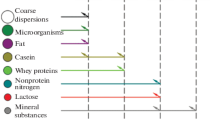Abstract
Mathematical modelling, using mass balances, of a polymer/salt two phase aqueous protein fractionation process with phase chemical recycle, is used to investigate the effect of several process parameters on phase chemical requirement. Data available on whey protein fractionation to produce α-lactalbumin and β-lactoglobulin are used. Parameters considered include the fraction of phase chemicals recycled, concentrating of phase chemicals in the recycles, bottom phase polymer concentration, concentrating of protein in the feed stream, and the effect of protein build-up due to recycling. The analysis shows that considerable savings in phase chemical requirement can be made by selecting appropriate process parameter values.
Similar content being viewed by others
Abbreviations
- f s :
-
stage 1 salt recycle concentration factor
- i :
-
subscript i (= 1 or 2) represents a stage
- j :
-
subscript j (= A, B, or O) represents a protein type (A: protein A, B: protein B, O: contaminant proteins)
- K ji :
-
partition co-efficient of protein j in stage i=protein concentration in top phase divided by that in bottom phase
- n p :
-
fraction of polymer recycled from stage 2 to stage 1
- n s :
-
fraction of stage 1 salt recycled after ultrafiltration
- V v :
-
percentage volume ratio=volume of top phase/total volume
- V r :
-
phase volume ratio=volume of top phase/volume of bottom phase
- Z 1,Z 2,Z 3 :
-
constants
- ρ p :
-
polymer density
- ρ s :
-
salt density
- x b :
-
polymer concentration in bottom phase
- x i :
-
polymer concentration in a stage
- x rp :
-
polymer concentration in polymer recycle entering stage 1
- x rs :
-
polymer concentration in salt recycle entering stage 1
- x t :
-
polymer concentration in top phase
- y b :
-
salt concentration in bottom phase
- y i :
-
salt concentration in a stage
- y rp :
-
salt concentration in polymer recycle entering stage 1
- y rs :
-
salt concentration in salt recycle entering stage 1
- y t :
-
salt concentration in top phase
- E 2 :
-
flowrate of stage 2 recycle bleed/make-up
- F :
-
feed flowrate
- G :
-
top phase flowrate leaving stage 1
- H :
-
top phase flowrate leaving stage 2
- I :
-
bottom phase flowrate leaving stage 1
- J :
-
bottom phase flowrate leaving stage 2
- P 1 :
-
fresh polymer flowrate to stage 1
- R 1 :
-
permeate flowrate leaving ultrafiltration unit after stage 1
- R 2 :
-
permeate flowrate leaving ultrafiltration unit after stage 2
- R p :
-
flowrate in polymer recycle entering stage 1
- R s1 :
-
flowrate in salt recycle entering stage 1
- R s2 :
-
flowrate in salt recycle entering stage 2
- S 1 :
-
fresh salt flowrate to stage 1
- S 2 :
-
fresh salt flowrate to stage 2
- C jf :
-
protein concentration in feed
- C jg :
-
protein concentration in top phase leaving stage 1
- C jh :
-
protein concentration in top phase leaving stage 2
- C ji :
-
protein concentration in bottom phase leaving stage i
- C jrp :
-
protein concentration in polymer recycle entering stage 1
- C jsi :
-
protein concentration in stage i
- C nm :
-
total protein concentration in stage or stream m
- C ui :
-
concentration of total protein and polymer after stage i ultrafiltration
References
Maubois, J.L.; Ollivier, G.: Milk protein fractionation. International Dairy Federation Special Issue, No. 9201 (1991) 15–22
Chen, J.P.: Partitioning and separation of α-lactalbumin and β-lactoglobulin in PEG/potassium phosphate aqueous two-phase systems. Journal of Fermentation and Bioengineering, 73, 2 (1992) 140–147
Kroner, K.H.; Hustedt, H.; Kula, M.R.: Extractive enzyme recovery: economic considerations. Process Biochemestry 10 (1984) 170–179
Viede, A.; Lindbach, T.; Enfors, S.O.; Recovery of β-galactosidase from a poly (ethylene glycol) solution by diafitration. Enzyme Microbiology Technology 11, 11 (1989) 744–751
Greve, A.; Kula, M.R.: Recycling of salts in partition protein extraction processes. Journal of Chemical Technology and Biotechnology 50 (1991) 27–42
Hustedt, H.; Kroner, K.H.; Papamichael N.: Applications of two phase partioning in biotechnology. In: Walter, H.; Brooks, D.E.; and Fisher D. (Eds.): Partitioning in aqueous two phase systems, pp. 529–589. Academic Press, Orlando, Florida, 1985
Author information
Authors and Affiliations
Rights and permissions
About this article
Cite this article
Fitzpatrick, J.J., Engler, C.R. Mass balance considerations for chemical recycling in two phase aqueous fractionation of proteins. Bioprocess Eng. 13, 149–155 (1995). https://doi.org/10.1007/BF00369698
Received:
Issue Date:
DOI: https://doi.org/10.1007/BF00369698




